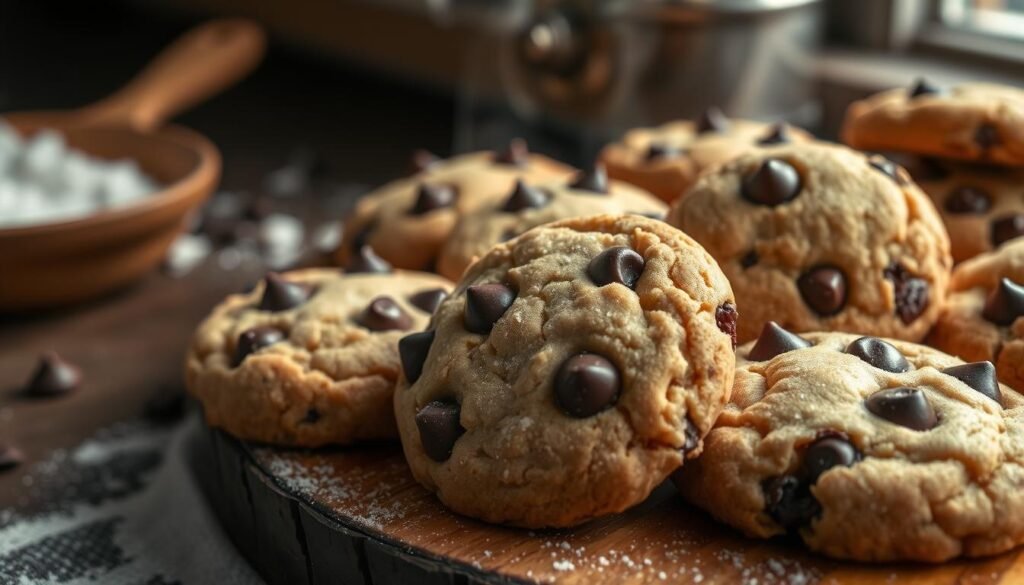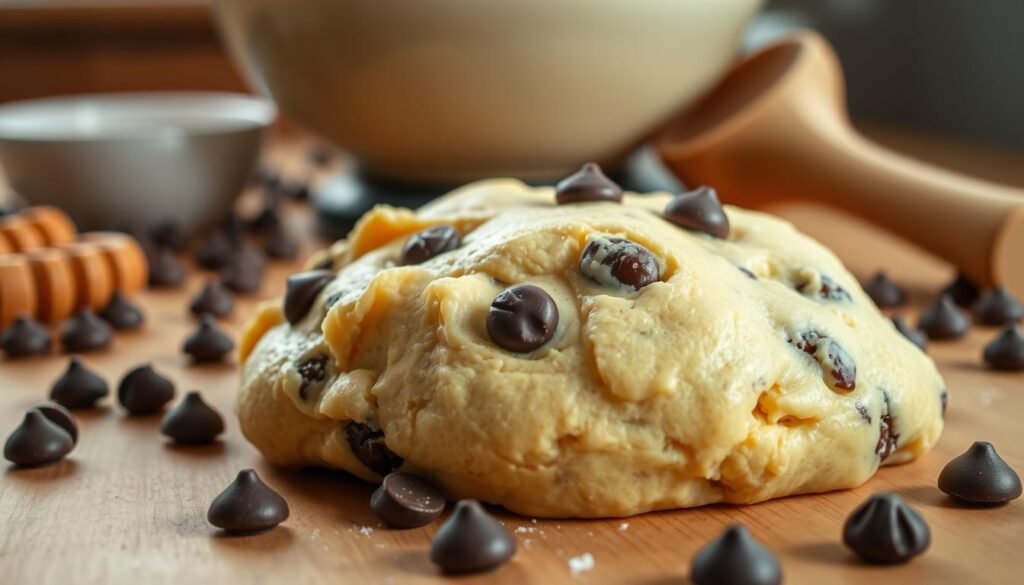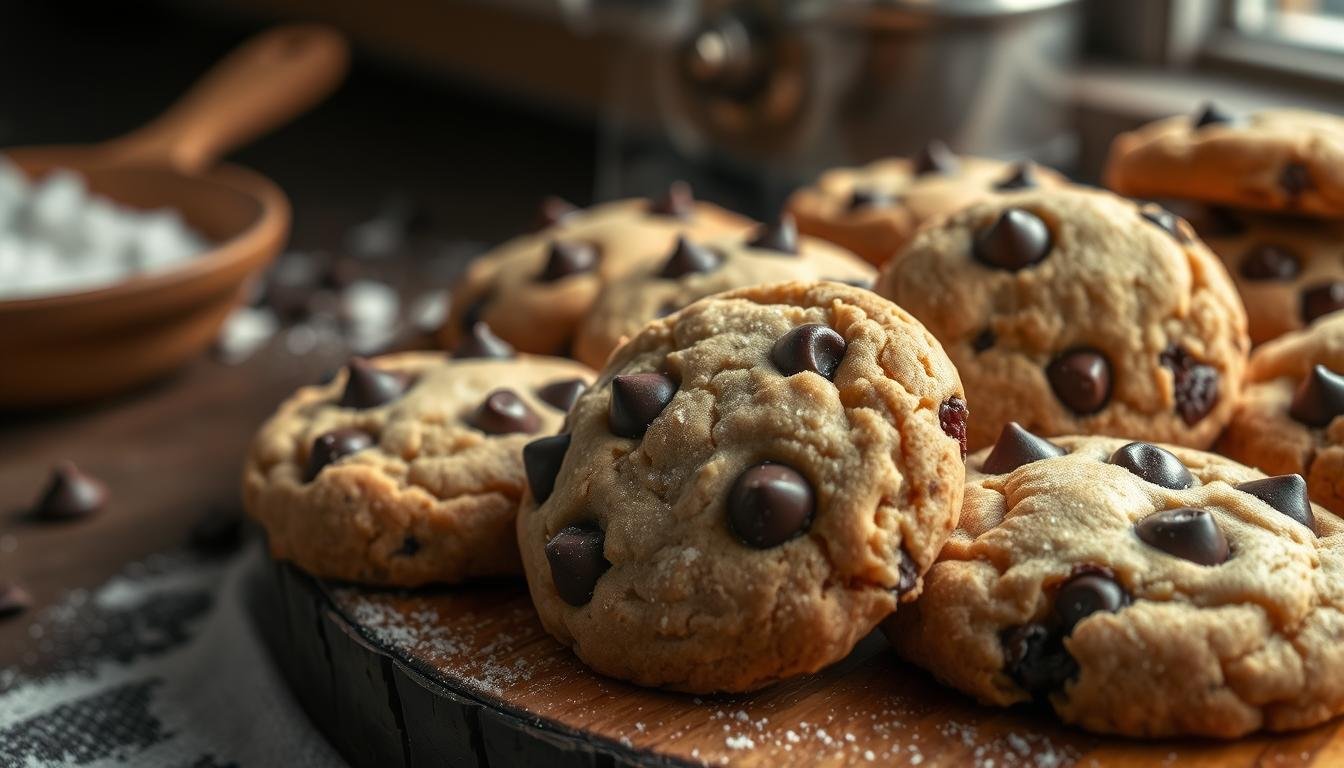Soft and chewy chocolate chip cookies are a beloved baking classic, capturing the hearts (and taste buds) of millions. The secret to achieving the perfect cookie texture lies in using the right ingredients and techniques. By incorporating melted butter, a higher ratio of brown sugar to white sugar, and a touch of cornstarch, you can create cookies with crisp edges and gooey, irresistible centers.
What’s more, this recipe doesn’t require the use of a mixer, making it an accessible option for bakers of all skill levels. The result? Cookies that are not only delectable but also easy to prepare. Whether you’re a seasoned baker or just starting your cookie-making journey, this guide will walk you through the steps to crafting soft and chewy cookies that will have your family and friends clamoring for more.

Key Takeaways
- Soft and chewy cookies can be achieved through the use of melted butter, a higher ratio of brown sugar to white sugar, and cornstarch.
- This recipe is mixer-free, making it accessible for bakers of all experience levels.
- The cookies feature crisp edges and gooey, irresistible centers.
- The recipe yields a large batch of approximately 38 cookies, perfect for sharing or storing.
- Careful attention to ingredient measurements and chilling the dough are key to successful baking.
Understanding the Characteristics of Soft and Chewy Cookies
Achieving the perfect balance of softness and chewiness in cookies is an art. The key lies in understanding the underlying cookie chemistry and the interplay between the various ingredients. From the choice of flour and sweeteners to the baking time and temperature, each factor plays a crucial role in determining the cookie consistency, whether it’s soft baked cookies or the coveted chewy cookie secrets.
What Makes Cookies Soft?
Soft cookies require a higher moisture content in the dough, which can be achieved through strategic ingredient substitutions or baking techniques. For instance, using more brown sugar than white sugar can contribute to a softer, chewier texture, as brown sugar contains more moisture-retaining molasses.
The Role of Chewiness
Chewiness in cookies is characterized by a dense, slightly underbaked center and a distinctive “Saturn’s ring” region that requires some masticating effort. The ideal cookie should have tender, crisp edges with a fudgy, chewy interior – a balance that can be attained through careful dough preparation and baking methods.
“The key to chewy cookies is a balance of moisture and structure. Too much moisture leads to a cake-like texture, while too little results in dry, crumbly cookies.”
By understanding the nuances of cookie consistency, bakers can unlock the secrets to creating soft, chewy cookies that delight the senses and satisfy the cravings of even the most discerning cookie connoisseurs.
Choosing the Right Ingredients
When it comes to baking the perfect soft and chewy cookies, the secret lies in selecting the right ingredients. From the type of flour to the sweeteners used, each component plays a crucial role in determining the final texture and flavor of your cookie creations.
Types of Flour to Use
All-purpose flour is a popular choice for cookie baking, as it provides a balanced structure and tender crumb. However, if you’re aiming for a chewier texture, bread flour can be a useful alternative. Bread flour contains more gluten, which can increase the chewiness of your cookies.
Sweeteners: Brown Sugar vs. Granulated Sugar
The choice between brown sugar and granulated sugar can greatly impact the softness and chewiness of your cookies. Brown sugar contains more moisture than white sugar, contributing to a moister, chewier texture. Replacing a portion of the granulated sugar with brown sugar, or even using more brown sugar than white, can result in a softer, chewier cookie.
The Importance of Eggs
Eggs play a vital role in achieving the perfect soft and chewy cookie. An extra egg yolk can increase the richness and chewiness of the dough, while the additional fat and emulsifying properties of the yolk help retain moisture. Melted butter, when used in conjunction with slightly more flour, can also enhance the chewiness of your cookies.
| Ingredient | Impact on Cookie Texture |
|---|---|
| Bread Flour | Increases chewiness due to higher gluten content |
| Brown Sugar | Adds moisture and chewiness compared to granulated sugar |
| Extra Egg Yolk | Enhances richness and chewiness |
| Melted Butter | Contributes to a chewier texture when used with slightly more flour |
By understanding the role that each ingredient plays in creating soft and chewy cookies, you can confidently experiment and adjust your recipes to achieve your desired texture and flavor profile. Embrace the art of cookie baking and unlock the secrets to perfectly soft cookie dough and delightfully chewy cookies.
Measuring Ingredients Accurately
Precise measurement is the key to consistently baking perfectly chewy cookies. Using the right tools and techniques can make all the difference in achieving the perfect cookie texture and flavor. Let’s explore the importance of accurate measuring and how to avoid common measuring mistakes.
Using Kitchen Scales vs. Measuring Cups
While measuring cups are a common household tool, a kitchen scale is the most accurate way to measure dry ingredients like cookie baking tips. Flour, for example, can easily be overpacked in a measuring cup, leading to up to 50% more flour than the recipe requires. A scale ensures you get the exact amount needed for the perfect cookie texture.
Liquid ingredients, on the other hand, should be measured using liquid measuring cups to ensure precise volumes. Trying to measure liquids in a dry measuring cup can lead to inaccurate results.
Common Measuring Mistakes to Avoid
- Overpacking flour in measuring cups
- Using liquid measuring cups for dry ingredients
- Failing to properly level off dry ingredients in cups
- Incorrectly converting between volume and weight measurements
Following the recipe exactly, including the specified measurement methods, is essential for achieving the perfectly chewy cookies you desire. Even small deviations can significantly impact the final result.
“Accurate measurement is the foundation for consistently baking great cookies. Don’t risk your hard work by guessing – use a scale and follow the recipe precisely.”
Preparing the Cookie Dough
Crafting the perfect soft and chewy cookies starts with the careful preparation of the cookie dough. The key to achieving the desired texture lies in the mixing techniques and the importance of chilling the dough.
Mixing Techniques for Best Results
When it comes to mixing the ingredients, it’s crucial to avoid overmixing. Overmixing can incorporate excess air into the batter, causing the cookies to go flat during baking. Instead, gently combine the wet and dry ingredients until they are just incorporated. This gentle approach helps maintain the soft and chewy texture you’re aiming for in the final cookies.
The Importance of Chilling the Dough
Chilling the cookie dough is a crucial step that shouldn’t be overlooked. Allowing the dough to rest in the refrigerator for at least 2-3 hours, or preferably overnight, helps the flavors develop and the texture to improve. The chilling process also allows the butter to firm up, resulting in thicker, more substantial cookies that don’t spread excessively during baking.
After the dough has chilled, let it sit at room temperature for about 10 minutes before shaping and baking. This allows the dough to soften slightly, making it easier to scoop and shape into perfect rounds.

“The recipe for super soft and chewy chocolate chip cookies has received over 11 million page views since 2013, and thousands of positive reviews attest to its popularity.”
By focusing on the proper mixing techniques and the importance of chilling the dough, you’ll be well on your way to creating soft, chewy cookie recipe that are sure to delight your family and friends.
Baking Tips for Perfect Cookies
To achieve the perfect balance of soft and chewy cookies, paying close attention to oven temperature and baking technique is crucial. Let’s dive into some key tips that will help you bake cookies that are just the right texture.
Oven Temperature: Why It Matters
Maintaining the proper oven temperature is essential for baking soft and chewy cookies. The ideal temperature range is 325°F (163°C) to 350°F (177°C). Preheating the oven to 325°F (163°C) will ensure your cookies bake evenly and develop that desirable soft and chewy texture.
Baking in Batches vs. All at Once
When baking cookies, it’s best to work in batches rather than trying to bake them all at once. Baking in smaller batches allows for more even heat distribution, preventing your cookies from drying out or becoming overly browned on the edges. The pan-banging technique, where you slam the baking sheet on the counter midway through baking, can also produce chewier cookies with lacy-crisp edges.
| Baking Tip | Benefit |
|---|---|
| Preheat oven to 325°F (163°C) | Ensures even baking and soft, chewy texture |
| Bake in smaller batches | Promotes even heat distribution and prevents drying or overcooking |
| Utilize the pan-banging technique | Creates chewier cookies with lacy-crisp edges |
By following these cookie baking tips, you’ll be well on your way to achieving the perfect, perfectly chewy cookies every time.
How to Avoid Dry Cookies
When it comes to soft baked cookies and chewy cookie secrets, preventing your cookies from drying out is key. Lightly browned edges are a telltale sign that your cookies are done, but it’s important to avoid overbaking them. Cookies continue to set and firm up as they cool, so it’s best to remove them from the oven a minute or two before they reach the maximum baking time in the recipe.
Signs of Overbaking
Overbaked cookies will have a crunchy, dry texture throughout. To ensure your soft baked cookies and chewy cookie secrets remain moist, keep an eye on them during the final minutes of baking. Remove the cookies from the oven when the edges are just starting to turn golden brown.
Adding Moisture to Your Cookies
- Use a mix of melted butter and vegetable oil in your cookie dough. The melted butter adds richness, while the oil helps keep the cookies soft and chewy.
- Incorporate a 50-50 blend of brown sugar and granulated sugar. The molasses in brown sugar adds moisture and chewiness to the cookies.
- Add an extra egg yolk or two to your dough. The fat in the yolks helps tenderize the cookies.
- Consider using bread flour, which has a higher protein content than all-purpose flour. The extra gluten helps create a chewier texture.
By following these tips, you can ensure your soft baked cookies and chewy cookie secrets retain their delightful texture long after they come out of the oven.

Flavor Variations for Soft and Chewy Cookies
Baking cookies is an art form, and the possibilities for creating unique and delectable flavors are endless. Whether you prefer the classic chocolate chip or crave something a little more adventurous, there’s a soft and chewy cookie recipe out there to satisfy your sweet tooth.
Classic Chocolate Chip Cookie Recipe
The chocolate chip cookie is a timeless favorite, and it’s no wonder why. This classic recipe yields soft, chewy cookies that are bursting with rich, chocolaty goodness. The key to achieving the perfect texture is to use a combination of melted butter, brown sugar, and an extra egg yolk. With just the right balance of ingredients, you’ll end up with a batch of chewy cookie perfection.
Adding Nuts and Other Mix-Ins
- Take your cookies to the next level by incorporating various mix-ins. Nuts like pecans or walnuts add a delightful crunch and a hint of nutty flavor.
- Dried fruits, such as cherries or cranberries, provide a tangy contrast to the sweetness of the dough.
- Swirling in different types of chocolate, from white chocolate chips to milk chocolate chunks, creates a rich and indulgent experience.
The possibilities are endless when it comes to customizing your soft baked cookie perfection. Experiment with different flavor combinations to find your new favorite. Whether you prefer classic or creative, the key is to have fun and let your creativity shine through in every bite.
“Soft, chewy cookies are a classic comfort food that bring joy to people of all ages. With endless flavor possibilities, there’s a cookie recipe out there to satisfy every craving.”
Storing Soft and Chewy Cookies
Once you’ve mastered the art of baking the perfect soft baked cookie perfection or chewy cookie secrets, it’s important to know how to properly store your delightful creations to maintain their freshness and texture. Follow these best practices to keep your soft and chewy cookies at their prime.
Best Practices for Freshness
To preserve the soft, moist texture of your cookies, store them in an airtight container at room temperature. This prevents air exposure, which can quickly dry out the cookies. Avoid storing them in a cookie jar, as the open design allows air to circulate and can cause the cookies to become stale.
For longer-term storage, you can freeze your cookie dough or baked cookies. To freeze cookie dough, scoop the dough into balls, chill them in the freezer for 1 hour, then transfer to a freezer-safe bag. This way, you can bake fresh cookies straight from the freezer whenever the craving strikes.
How to Freeze Your Cookies
- Baked cookies can be frozen for up to 8 months for unfrosted cookies and up to 6 months for cookie dough.
- To freeze baked cookies, let them cool completely, then place them in a single layer in a freezer-safe bag or airtight container.
- When ready to enjoy, thaw the cookies at room temperature or reheat them in the oven for a few minutes to restore their soft, chewy texture.
By following these simple storage tips, you can savor the soft baked cookie perfection and chewy cookie secrets you’ve worked so hard to create for days or even months to come.
“The secret to keeping cookies soft and chewy is all in the storage technique.”
Common Mistakes and How to Fix Them
Baking soft and chewy cookies can be tricky, but understanding common mistakes and how to address them can help you achieve baking perfection. One frequent issue is flat cookies, which can result from not chilling the dough or using too little flour. To fix this, ensure you chill the dough for at least a few hours, or up to 24 hours, to allow the ingredients to fully hydrate and develop flavor. Additionally, measure your flour accurately by spooning it into the measuring cup rather than dipping and scooping, as the latter can lead to packing in too much flour.
Troubleshooting Flat Cookies
If your cookies come out flat, the culprit may be insufficient chilling time or not using enough flour. Be sure to chill the dough for the recommended duration, and consider adding a tablespoon or two more flour to the recipe to achieve the desired thickness. An oven thermometer can also help ensure your oven is at the correct temperature, as fluctuations can impact cookie spread.
Solutions for Cookies that Spread Too Much
On the other hand, if your cookies spread excessively during baking, the issue may be with the butter temperature. Make sure your butter is just softened, not melted, and that the dough is properly chilled before baking. If cookies continue to spread, you can try reshaping them with a spoon immediately after removing them from the oven. Proper cookie placement, with at least 2 inches between each, can also help prevent excessive spreading and ensure even baking.
FAQ
What makes cookies soft and chewy?
The key to achieving the perfect soft and chewy cookie texture lies in using specific ingredients and techniques, such as melted butter, more brown sugar than white sugar, cornstarch, and an extra egg yolk.
How do I achieve a chewier cookie texture?
Chewiness is characterized by a dense, slightly underbaked center and a clenched tightness that requires some mastication. Using more brown sugar than white sugar, adding an extra egg yolk, and melting the butter can all contribute to a chewier cookie texture.
What type of flour should I use for soft and chewy cookies?
All-purpose flour is commonly used, but bread flour can increase chewiness in some recipes. The key is to measure the flour accurately, as even small changes can alter the final result.
How important is it to chill the cookie dough?
Chilling the dough for at least 2-3 hours or overnight is crucial for thicker cookies and enhanced flavor. After chilling, letting the dough sit at room temperature for 10 minutes before shaping is also recommended.
How can I avoid overbaking my cookies?
Watch for lightly browned edges as a sign that cookies are done, and avoid overbaking, as cookies continue to set as they cool. Baking in batches and using the pan-banging technique can also help produce chewier cookies with lacy-crisp edges.
What can I do to make my cookies more moist and chewy?
Using a 50-50 mixture of melted butter and vegetable oil, or incorporating extra egg yolks, can result in softer, chewier cookies with a beautiful cracked appearance.
How do I store soft and chewy cookies to maintain freshness?
To maintain freshness, store cookies in an airtight container at room temperature. For longer storage, freeze cookie dough balls for up to 3 months and bake them directly from the freezer, adding an extra minute to the baking time.
Why are my cookies spreading too much during baking?
Flat or spreading cookies can be the result of not chilling the dough or using too little flour. Make sure the butter isn’t too warm and the dough is properly chilled before baking. If cookies spread during baking, use a spoon to reshape them immediately after removing them from the oven.
